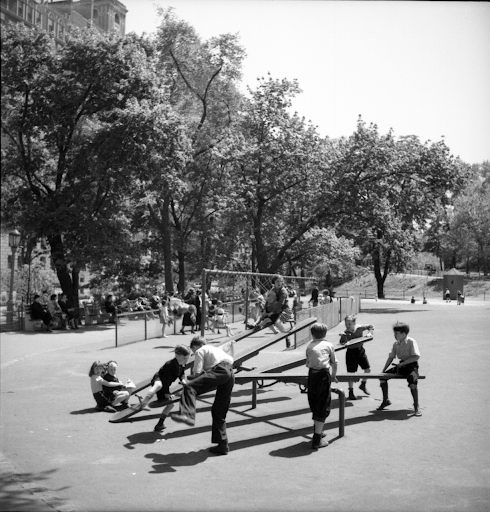Tuesday, August 24, 2021 – ONE OF THE GRANDIOSE APARTMENTS OF THE FAMED UPPER WEST SIDE


TUESDAY, AUGUST 24, 2021
The
450th Edition
From the Archives
THE DORILTON
APARTMENTS
REVIEW BY CARTER HORSLEY
When I was a baby my parents lived in
an apartment house on the same block as the Dorilton. There are many photos of myself in a carriage
in front of the most impressive architecture. (Cannot find the photos, but still looking)

History
In his book, “Historic Manhattan Apartment Houses,” (Dover Publications, Inc., 1996), Andrew Alpern illustrates the building on his cover and remarks on its “overblown ostentation,” quoting a cynical review by famed critic Montgomery Schuyler,
Alpern noted that Schuyler was upset at the “stone balls on the gate posts of the entrance, two feet in diameter, left there for titans to roll at ten pins.”
Indeed, in his 1979 book, “The City Observed, New York, A Guide To The Architecture of Manhattan,” (Vintage Books, a division of Random House) Paul Goldberger wrote that “Now the building seems more to be pitied than censored, a rather too eager-to-please piece of Second Empire foppery. Once, some thought that a mansard roof and a lot of sculpture and cartouches make a building French; now we know better. Still, it is sad to see this building, for all its foolishness, in the sorry state of decay it has descended to, with unsympathetic storefronts along the Broadway side and a façade that clearly has not been cared for in years.”


“In its day,” Christopher Gray observed in his September 30, 1990 “Streetscapes” article in The New York Times, “it was considered the architectural equivalent of a fist fight,” adding that “over the years large hunks of its blowsy decoration have been removed, leaving it more curiosity than contretemps.”
Mr. Gray noted that the building’s “limestone lower stories are voluptuous in their deep carving,” adding that “the middle section is an epidemic of quoining, ironwork, brackets, cartouches, oriels and other details.” When it opened, it had “separate servant and passenger elevators, filtered water, separate tenant storerooms and a provision for charging electric automobiles,” according to Mr. Gray.
“In 1902,” Mr. Gray continued, “the critic Montgomery Schuyler chose the Dorilton for his Architectural Aberrations column in Architecture Record. He remarked on ‘the wild yell with which the fronts exclaim, ‘Look at me,’ as if somebody were going to miss seeing a building of this 12-stories area.’ ‘The incendiary qualities of the edifice may be referred, first to violence of color, then to violence of scale, then to violence of ‘thinginess,’ to the multiplicity and importunity of the details.’ ‘Motley elements,’ he said, ‘set the sensitive spectator’s teeth on edge.’”

Goodness gracious. Presumably the renowned Mr. Schuyler never stepped foot into a full-blown Baroque masterpiece in Europe! His sanctity might not have survived intact!
By 1974, the city’s Landmarks Preservation Commission had the good graces to declare the building a landmark, noting that it was “exceptionally handsome.”
About a decade later, the mansard roof was re-slated and some of the dormers were rebuilt but a 10th floor cornice could not be rebuilt, according to Mr. Gray, because of cost, and for “a lesser cornice at the 11th floor level, also missing, the bare wall was painted in trompe l’oeil to imitate the banding and shadows of the original. Designed by John Wright Stephens and Jonathan Williams it is an amusing deception.”

One of the building’s early residents was William Zeckendorf.
In August, 1938, the building was sold at auction under foreclosure by the Dry Dock Savings Institution.
“It was only with conversion as a cooperative in 1984 that the depredations of decades began to be turned along….and with patience, imagination and a large amount of money, the Dorilton may yet recover its lost outrageous glory,” Alpern wrote.
“Particularly distinctive are the two Brobdingnagian, classically draped maidens serenely surveying the passing scene from their perch overlooking Broadway at the balustraded fourth floor. Comparably unusual, along West 71st Street, are the two pairs of near-nude muscular men supporting (with great effort) iron-railed balconies at the sixth floor,” Mr. Alpern observed.
A fairer assessment of the building can be found in “New York 1900, Metropolitan Architecture and Urbanism 1890-1915,” (Rizzoli International Publications, 1983). In it, authors Robert A. M. Stern, Gregory Gilmartin and John Montague Massengale wrote that “The Dorilton’s bold massing dominated Sherman Square….The Dorilton was distinguished by the astonishing voluptuousness of its details….It was precisely the intricacy and the burly swagger of the Dorilton which was the source of its drama and expressed the optimism of the new century.”
Over the years, the Dorilton was overshadowed by the high visibility of the nearby Ansonia, the celebrated legends of the Dakota and the skyscraping glories of the multi-towered apartment buildings of Central Park West.
Despite decades of neglect, the Dorilton has survived, thank goodness, a masterpiece of urban architecture, a lively, enriching edifice that Paris would love to have.
TUESDAY PHOTO OF THE DAY SEND TO ROOSEVELTISLANDHISTORY@GMAIL.COM

MONDAY PHOTO OF THE DAY
ORIGINAL RENDERING OF THE
TROLLEY KIOSK, NOW THE RIHS VISITOR CENTER
ED LITCHER AND ANDY SPARBERG GOT IT RIGHT!!

Text by Judith Berdy
Thanks to Bobbie Slonevsky for her dedication to Blackwell’s Almanac and the RIHS
Thanks to Deborah Dorff for maintaining our website
Edited by Melanie Colter and Deborah Dorff
All image are copyrighted (c) Roosevelt Island Historical Society unless otherwise indicated
Carter B. Horsley, a former journalist for The New York Times, The International Herald Tribune and The New York Post. Mr. Horsley is also the editorial director of CityRealty.com.
FUNDING PROVIDED BY ROOSEVELT ISLAND OPERATING CORPORATION PUBLIC PURPOSE GRANTS CITY COUNCIL REPRESENTATIVE BEN KALLOS DISCRETIONARY FUNDING THRU DYCD


Copyright © 2021 Roosevelt Island Historical Society, All rights reserved.Our mailing address is:
rooseveltislandhistory@gmail.com

Leave a comment